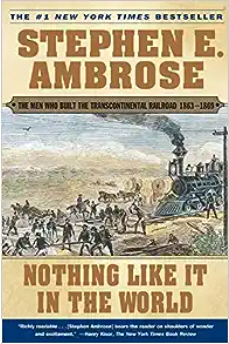‘Nothing Like It in the World,’ by Stephen E. Ambrose
 “While originally well received by the public at large, many reviews of the book by professional historians and other scholars, researchers, and experts in the field appearing in the weeks and months after its release were highly critical of the work as being poorly researched and edited as well as inadequately fact checked. Several longer form papers and commentaries were also produced by well-known experts on the history of the Pacific Railroad which documented in detail that the book was rife with factual errors, misquotes, contradictions, demonstrably misleading and/or inaccurate statements, and unsupported conclusions.” – Wikipedia
“While originally well received by the public at large, many reviews of the book by professional historians and other scholars, researchers, and experts in the field appearing in the weeks and months after its release were highly critical of the work as being poorly researched and edited as well as inadequately fact checked. Several longer form papers and commentaries were also produced by well-known experts on the history of the Pacific Railroad which documented in detail that the book was rife with factual errors, misquotes, contradictions, demonstrably misleading and/or inaccurate statements, and unsupported conclusions.” – Wikipedia
I first read this book when it came out in 2001. It was good reading and taught me a lot of things that only received cursory attention in high school and college history courses. Naturally, I was discouraged by the negative reviews the book received over time. Ambrose died in 2002, so her wasn’t around to defend himself. Nonetheless, I still think the book is worth a look because it presents the general story of the road that I doubt most college students graduating with a B.A. don’t know about. Most important are the facts that President Lincoln was the primary force behind a transcontinental railroad and that much of the surveying and other initial work began while the North was fighting a civil war.
From the Publisher“In this New York Times bestseller, Stephen Ambrose brings to life the story of the building of the transcontinental railroad, from the men who financed it to the engineers and surveyors who risked their lives to the workers who signed on for the dangerous job.
“Nothing Like It in the World gives the account of an unprecedented feat of engineering, vision, and courage. It is the story of the men who built the transcontinental railroad—the investors who risked their businesses and money; the enlightened politicians who understood its importance; the engineers and surveyors who risked, and sometimes lost, their lives; and the Irish and Chinese immigrants, the defeated Confederate soldiers, and the other laborers who did the backbreaking and dangerous work on the tracks.
“The U.S. government pitted two companies—the Union Pacific and the Central Pacific Railroads—against each other in a race for funding, encouraging speed over caution. Locomotives, rails, and spikes were shipped from the East through Panama or around South America to the West or lugged across the country to the Plains. In Ambrose’s hands, this enterprise, with its huge expenditure of brainpower, muscle, and sweat, comes vibrantly to life.”
The Central Pacific Railroad started in Sacramento and was built towards the east. It merged with Union Pacific in 1996. At present, the primary class-one railroads which operate freight lines which are often used b Amtrak, are the Union Pacific (UP), Burlington Northern Santa Fe (BNSF), Canadian Pacific (BP) which recently acquired Kanas City Southern, Norfolk-Southern NS), and CSX Transportation.
That first railroad line, along with road operating in the North or South has become quite a sizeable rail network. Watching today’s tack crews add track or repair track gives one an appreciation of the manual work done on the CP by Chinese employees and the work done on the UP by Irish employees.
–Malcolm
Malcolm R. Campbell and his wife worked for a railway museum, restored old cars (including the one used by President Harding, and operated locomotives to move a large amount of rolling stock around the property which grew from 12 acres to 30 acres while we were there.



